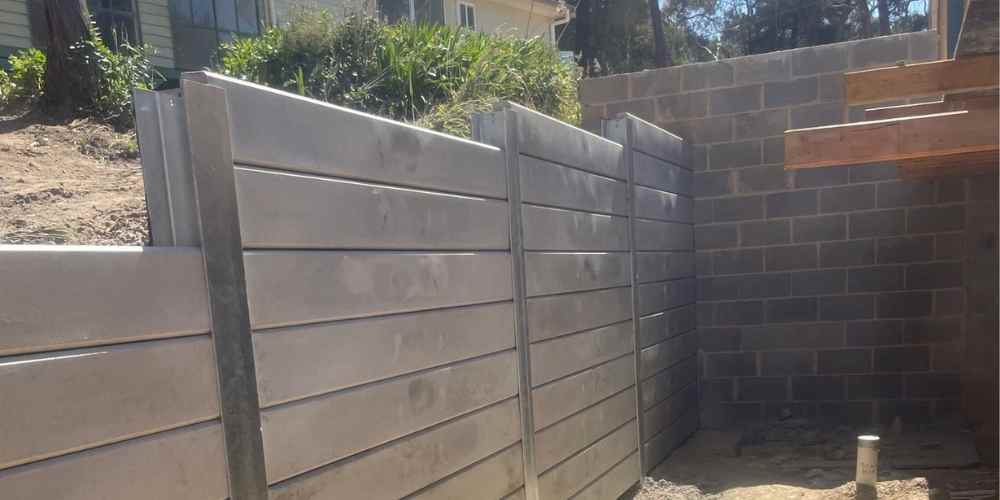4 Things to Know About Retaining Wall Design
Some people think retaining wall design is easy, but there’s generally a lot more going on behind the scenes with retaining walls ideas than most people realize. Failures of retaining walls can cause significant property and service damage, and catastrophic injury and death.
In this article, we’ll walk you through the why, what, and how of retaining wall height regulations, base, soil compaction, and drainage approaches.
What is a Retaining Wall?
A retaining wall is a construction that keeps soil behind it in place. Concrete blocks, poured concrete, treated timbers, pebbles, and boulders are just some of the materials that may be utilized to build retaining walls. Some are simple to use, while others have a shorter lifespan, but they all have the ability to retain soil. A retaining wall contractor can help you decide what material is best to use and can assist in the proper construction of your wall.

Things to Consider when Constructing a Retaining Wall
Base
To begin, a retaining wall is constructed on a sufficient foundation. The higher a wall is, the lower it should be put below ground level. The rest of the wall must be supported by a sturdy foundation of compacted dirt and at least a six-inch layer of compacted sand and gravel.
A base trench of 24 inches should be dug. The length of the wall is (60 cm) broad. The trench will be 6 inches deep. (15.24 cm) + an extra inch (2.54 cm) every 1 ft (30 cm) of wall height required for the amount of buried block required. With a walk behind the plate compactor, compress the base trench a minimum of two times. The foundation soils at the bottom of the base trench must be firm and solid. Remove any heavy clay or moist soils, as well as any previously excavated areas, and replace with granular material compacted in an 8-inch layer.
Tip: Dig the foundation trench 18 in (46 cm) deep for walls less than 4 ft (121 cm).
18 in (46 cm) broad and 4 in deep (10 cm) plus more to accommodate for the quantity of buried blocks that will be required.
Soil Compaction
Compaction of the soil is a vital stage in constructing a robust and stable retaining wall. When we talk about creating a retaining wall at an angle, we’re referring to a construction called a gravity retaining wall, which is designed to lean inwards rather than outwards. We can practically, if not completely, balance the pressure imposed by the earth and the pressure exerted by the wall against each other in this manner.
Heavy machinery should be kept at least 3 feet (9 cm) away from the blocks’ back. The consolidation zone extends 3 feet (9 cm) into the infill soil from the back of the block. Within the consolidation zone, only walking behind mechanical plate compaction equipment is permitted for at least two passes.
Higher degrees of compaction can be achieved inside the consolidation zone by lowering the lifts to 4 in (10cm) and compacting with walk-behind compaction equipment, starting at the retaining wall and moving parallel to it. Compacting in smaller lifts achieves higher degrees of compaction while avoiding lateral stresses on the retaining wall facing. The compaction machinery will have to go through many passes. Over time, higher degrees of compaction diminish settling.
Drainage
When constructing a retaining wall and installing cladding, proper drainage is one of the most important considerations. A small excavator can help with the proper installation of drainage, especially in areas where there is tight access. Mini excavator hire is available from any decent excavator hire business. Lay an agricultural drainage pipe with a geotextile sock (ag-pipe) behind the wall on a bed of 1-2 cm clean, free drainage material after placing the first course of blocks.
Make sure the retaining wall drainage pipe has a 1cm drop over 1m of wall length, a geotextile sock to prevent silt from plugging the drainage holes, and an exit at every low point, every 20 meters, and out the wall ends.
Height Regulations
When constructing a retaining wall, you may seek an engineer’s report or the services of a structural engineer. Do you know how high a retaining wall has to be before it needs to be approved? Is it a large block retaining wall?
Because height regulations vary from state to state and even from council to council, only your local council can tell you for sure. The AS4678 – Earth Retaining Structures is an Australian design standard that addresses walls that have a height greater than 80 cm but less than 15 m and 70 degrees or more from horizontal excluding revetment constructions.
Although some states defer to local governments, most states have their own retaining wall height requirements that are used as a guideline before seeking approval: Australian Capital Territory with 40 cm, New South Wales with 100 cm, Queensland with 100 cm, South Australia with 20 cm, Victoria with 100 cm, and Western Australia with 50 cm.
You’ll need to seek council authorisation to create a higher retaining wall.
Conclusion
To guarantee a safe, efficient, and cost-effective retaining wall construction, it’s frequently advisable to have a retaining wall Australia Standard planned by an engineer and built by a suitably licensed retaining wall builder like us, Hammer Excavations.
